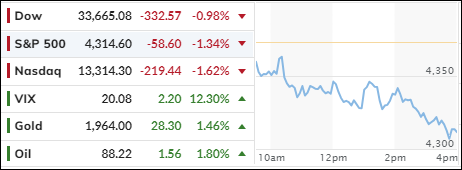
- Moving the markets
The stock market had a rough day on Wednesday, after the S&P 500 got too close to its glass ceiling and bounced back down.
It was a busy day for earnings reports and rising interest rates, which made investors nervous and jittery. The 10-year bond yield jumped over 4.9%, the highest since 2007. That’s bad news for anyone who wants to buy a house, because the average 30-year mortgage rate just hit 8%, the highest since 2000. Ouch!
Earnings were a mixed bag, with only 10% of the S&P 500 companies reporting so far, according to FactSet. Most of them beat the low expectations, but that’s not saying much. The real question is what they expect for the future, and how the interest rates will affect their business.
Chip stocks like Nvidia and AMD had another bad day, as the U.S. government decided to limit their sales of AI chips to China. That’s a big blow to their growth prospects, and traders were quick to dump their shares.
The war between Israel and Hamas also weighed on the market, as investors flocked to gold as a safe haven. Gold prices soared again, along with energy and oil stocks. They were the only ones having a good time on Wednesday.
Banks were among the worst performers, especially Morgan Stanley, which dropped more than 6%. That was its worst day since June 2020. The short squeeze craze also fizzled out, as small-cap stocks took a nosedive.
With the AI sector in trouble, could we see a repeat of the Covid/Crypto boom and bust? Or is this just a temporary setback for the tech giants?
2. “Buy” Cycle (12/1/22 to 9/21/2023)
The current Domestic Buy cycle began on December 1, 2022, and concluded on September 21, 2023, at which time we liquidated our holdings in “broadly diversified domestic ETFs and mutual funds”.
Our International TTI has now dipped firmly below its long-term trend line, thereby signaling the end of its current Buy cycle effective 10/3/23.
We have kept some selected sector funds. To make informed investment decisions based on your risk tolerance, you can refer to my Thursday StatSheet and Saturday’s “ETFs on the Cutline” report.
Considering the current turbulent times, it is prudent for conservative investors to remain in money market funds—not bond funds—on the sidelines.
3. Trend Tracking Indexes (TTIs)
The S&P 500 reached its highest point in a while yesterday, namely its 50-day M/A, but then it fell sharply and pulled down all the other stock markets indices with it.
This could mean that the recent recovery from the bear market bounce is over, which was not very convincing anyway because of the rising interest rates.
Our TTIs show that the market is still in a downtrend, and we will need to see a momentum reversal before we change our strategy.
This is how we closed 10/18/2023:
Domestic TTI: -3.24% below its M/A (prior close –1.71%)—Sell signal effective 9/22/2023.
International TTI: -1.37% below its M/A (prior close -0.30%)—Sell signal effective 10/3/2023.
All linked charts above are courtesy of Bloomberg via ZeroHedge.
Contact Ulli